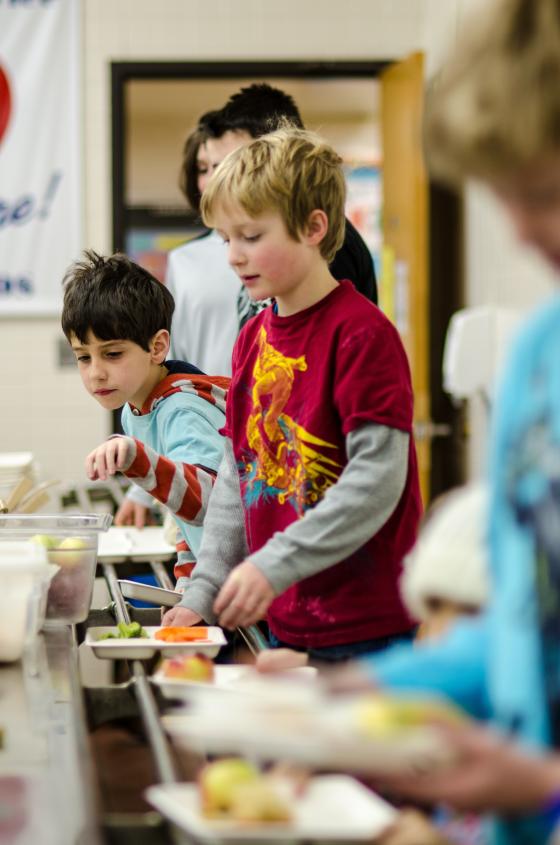Posted March 17, 2022 at 10:36am by Anonymous (not verified)
Universal Free School Meals

Written by Alida Duncan
Hunger Free Vermont’s vision is for Vermont’s school cafeterias and classrooms to be a welcoming place where all kids equally share meals together, and that school provide a learning lab for healthy eating—including exposure to local foods and creating localvores for life. This vision aligns with Vermont’s Farm to Plate institutional consumption and food access goals. Hunger Free Vermont is helping Vermont reach its Farm to Plate food system plan goals while working to realize its vision for school meals by establishing Universal Free School Meals in Vermont’s schools. The Universal Free School Meals model helps schools maximize the funding available for school and afterschool meal programs, making it more feasible to incorporate more local foods in the meals.
What is Universal Free School Meals?
School meals have always been available for free to some students, depending on income. Parents have had to fill out a detailed income reporting form, which is then used to determine who is eligible for free lunch and who must pay the full price for their meal (as a result of advocacy from Hunger Free Vermont, Vermont’s Farm to School Network, and the School Nutrition Association of Vermont, the State of Vermont decided to eliminate a third category, the reduced-price meal, in 2013). Universal Free School Meal programs, made possible by the federal Community Eligibility Provision (CEP), do away with these categories and provide school meals to all students for free. Schools using this program have high percentages of children participating in 3SquaresVT (aka SNAP or food stamps), Reach Up (TANF), or other state programs.
When everyone in the school is receiving free lunch, no child is singled-out as unable to afford lunch and no families end up in debt to the meal program at the end of the year. This helps families who come close to eligibility requirements for free lunch but don’t quite meet them, and also helps keep school finances healthy. Moving to a universal meals model allows school systems to spend less time and money on administration, putting it instead into improving the quality of the food and increasing participation in the meal program.
Lessons Learned in Brattleboro
Hunger Free Vermont’s three-year collaboration with Food Connects in Windham Southeast Supervisory Union (WSSU) has proven that expanding meal participation is a powerful factor for success in the Farm to School equation. Windham Southeast Supervisory Union’s administrative leaders and food management company, Cafe Services, have been working with Hunger Free Vermont and Food Connects to steadily improve meal quality, expand the meal programs offered, increase student participation, and make meal programs universal (offered at no charge to all students) whenever possible. The results have been impressive, with nearly all of the district’s schools now offering universal meals in afterschool programs, a breakfast in the classroom program at one of the schools that has nearly 90% of students eating breakfast every day, and now—with the addition of three Brattleboro elementary schools jumping on board—universal breakfast and lunch for all elementary school students in Brattleboro.
Bringing universal meals to Brattleboro schools required a coordinated effort of the school board, administration, food service staff, and advocates from Food Connects and Hunger Free Vermont. Food Connects has a strong history of collaboration with Windham schools, with eight out of ten of the Windham Southeast Supervisory Union schools investing budget funds in Food Connects’ Farm to School program. In addition to increasing local purchasing across all of the WSSU schools, collaboration with Food Connects has also brought new equipment to the kitchens to better process local foods; and engaged local educators in numerous workshops, conferences, and graduate-level courses. Hundreds of students have visited Food Connects’ organic School Harvest Farm, where they gained experience planting, tending and harvesting crops that are then sold to area school cafeterias. Food Connects also supported the elementary schools in establishing monthly taste tests featuring the Vermont Harvest of the Month, as well as in creating school gardens, compost systems, and harvest dinners.
Food Connects understands the importance of the Universal Free School Meals model in increasing spending power for a school so they can better afford local foods, improving the quality of meals, and further increasing the participation in the meal program. Increased participation means even more purchasing power, continuing the virtuous cycle. All of this collaborative work has resulted in more local foods in Brattleboro schools, and the same results are seen in all of the other 53 schools who have moved to Universal Free School Meals—institutionalizing consumption of local foods in Vermont’s schools.
